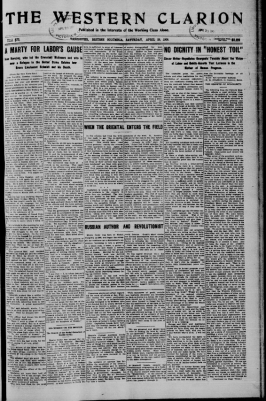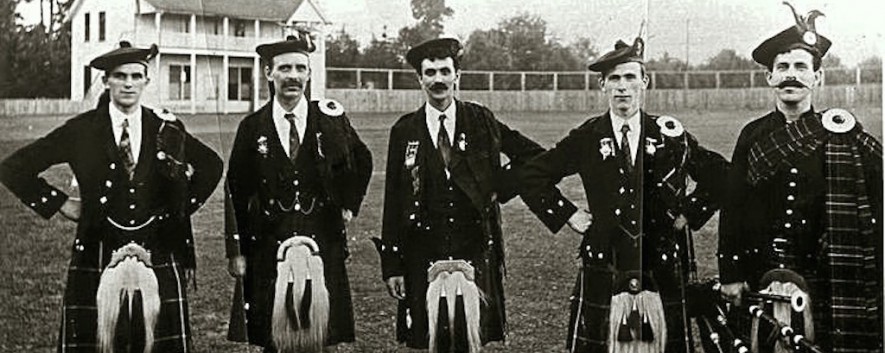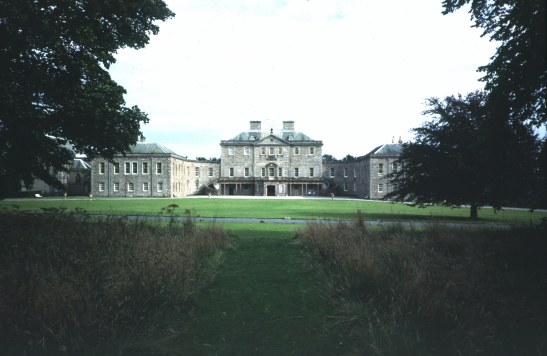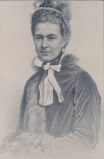At press time, Tessa Carolynn McGibbon had recently graduated with an undergraduate degree in History from Simon Fraser University with a focus on Canadian History. Currently, she is in the post graduate program at Simon Fraser University to become an elementary school teacher. Tessa aims to teach children about Canadian history in an engaging, fun, and informative way.
—
William Bennett, most commonly known as “Ol’ Bill,” is little-known in the history of the labour movement in Canada, yet his contribution was a very important one. Born into a humble family in Greenock, Scotland on May 8, 1881, Ol’ Bill saw first-hand the struggles of working-class life in urban Scotland. A founding member of the Communist Party of Canada and the Labour-Progressive Party, Ol’ Bill’s passion for the rights of workers and their families began at a young age leading him to join the Kier Hardie-led Independent Labour Party (ILP) in Glasgow in 1897 when he was just sixteen years old. “Young Wullie” was quickly welcomed into the ILP fold not only because at the time he was working in a barbershop, where he had access to many potential labour movement recruits, but also by other young socialists who saw him as one of their own like the young engineer Adam Lieper, who liked that Ol’ Bill “[lives] in the same close (alley) as I do, and he’s been reading the Labour Leader for some time now.”[1] Reading the Labour Leader, a small weekly British socialist paper, was a perfect reason for Ol’ Bill to have gained membership into the ILP because this humble working-class boy’s future would see him become one of the most notable journalists in a revolutionary socialist movement thousands of kilometers away in Canada.

William Bennett. http://collections.mun.ca/PDFs/radical/HeWroteForUs.pdf
After working for many years in Scotland helping various workers, especially miners, to get concessions from their employers and the government through various writings and speeches, Ol’ Bill moved to Canada. Ol’ Bill, like many other labour supporters of his generation, were dissatisfied with the slow pace at which social reforms for workers and their families were taking place. The (now) Labour Party’s conflict with the government largely involved opposition to the Boer War (1899-1902), which revealed the ill-health of many of the army recruits, many of who came from Britain’s urban slums. Why, asked Ol’ Bill, should “money and labor…be squandered on fighting in a needless war in Africa, when it could be much better used at home cleaning up the Glasgow slums[?]”[2]
Ol’ Bill arrived at his new home in Vancouver in 1907. Like many new immigrants, Ol’ Bill struggled to find work, so he did what he knew best and opened a barber shop in the skid road district of Vancouver (today centred around Hastings and Main), spreading the ideas of socialism to whoever sat in his chair. By 1912, Ol’ Bill joined the Socialist Party of Canada (SPC) and began to write for the party’s paper The Western Clarion (launched in 1903). That same year, Ol’ Bill tried running in the provincial election as the Vancouver City candidate for SPC, but sadly did not win.

The Western Clarion, April 28, 1906. https://open.library.ubc.ca/collections/bcnewspapers/wclarion/items/1.0318614#p0z-7r0f:
During most SPC rallies and public meetings in these years, Ol’ Bill acted as the chairmen, which involved speaking publicly, revealing his canny ability to make succinct and straight forward speeches, inspiring all of those who listened to him. In other words, Ol’ Bill was not one to ramble. For example, during his speech to the coal miners during the Vancouver Island miners’ lockout during 1912-13 he said:
Comrade chairman and fellow-workers: You all know what coal is, so I don’t have to go too deeply into that. Most of you here have to buy coal, so I don’t need to tell you much about that either. But…miners who dig the coal…are locked out…some call it a strike. What are you going to do about that?[3]
However, the First World War and the violent labour unrest of the Winnipeg General Strike in 1919, led Ol’ Bill to move away from the SPC. With other more radical thinkers, Ol’ Bill formed a new organization, the Workers’ Party of Canada in 1922, which became the Communist Party of Canada (CPC) in 1924. While working with the CPC, Ol’ Bill helped create the BC Workers’ News in 1935 (Pacific Tribune after 1946) which is where his well-known regular piece, “Short Jabs” began. Short Jabs was a concise column which he addressed various events, politics, and people through his humorous, blunt manner and was also found in other Party publications such as The People and The Advocate.

The I.W.W., Industrial Workers of the World, on strike against the Canadian Northern Railway, Yale District. http://search-bcarchives.royalbcmuseum.bc.ca/i-w-w-industrial-workers-of-world-on-strike-against-canadian-northern-railway-yale-district
Ol’ Bill’s influential 1936 booklet on the history of labour in BC, Builders of British Columbia, exposed the reality, as he saw it, of the struggles that labourers in the province had had to undertake since its foundation. He argued that men were being forced to work for the rich for little pay and horrible conditions, when the “founding families” of British Columbia gained all the profit and recognition as builders of the province.[4] Through his writing about issues such as, British Columbia lumber workers not having the right to unions, gave people agency to fight for their rights. For example, Ol’ Bill wrote:
The life of the logger, particularly, might be made to look idyllic in a storybook, but fact it was worse than chattel slavery. From dark to dark, 10, 12 and 14 hours of slavish, backbreaking soul-destroying labor; the vilest of food, discarded remnants of the slaughterhouses and the canneries; overloaded bunkhouses with vermin-infested, muzzle-loading, double-deck bunks, three decks in some cases, and for which the logger had to pack his own blankets; no sanitary conditions or wash-houses; swindled and robbed by employment sharks, grafting foremen and the steamboat companies. Such was the lot of the timber-beasts in B.C.’s banner industry.[5]

“Christina” a 35 ton climax of Abbot Timber Co. at the end of the rails; Michael Eert collection. http://search-bcarchives.royalbcmuseum.bc.ca/christina-35-ton-climax-of-abbot-timber-co-at-end-of-rails-michael-eert-collection
Through Ol’ Bill’s written word he inspired people to fight for the change in treatment toward workers and encouraged people to battle for their right to join unions. This meant workers of all backgrounds including Indigenous people. Bennett argued that despite being hindered by the Indian Agents whose “principle business is to keep the Indians [sic] out of the trade union movement…[Indigenous people] have played a great part in the struggles of the industries in which they work.”[6] This struggle led, for example, to the Lumber Workers’ Industrial Union of Canada expanding exponentially, becoming one of the most powerful unions in Canada. Because of this, lumber workers achieved higher wages, eight-hour work days, and better overall treatment in the camps. This is the legacy of Ol’ Bill’s efforts.

Bennett, William. Builders of British Columbia. 1936. Frontispiece.
Ol’ Bill passed away on the 31st of December 1949. Discovering Ol’ Bill’s contribution to the development of left-wing politics and labour rights in British Columbia is an important part of Canadian history. William “Ol’ Bill” Bennett’s dedication to all workers of any background demonstrates that the Canadian hero could be anyone starting with only a pair of scissors, a comb, and a pen.
© Tessa McGibbon
Notes
[1] Quoted in: Tom McEwen. He Wrote For Us: The story of Bill Bennett, Pioneer Socialist Journalist. (Vancouver: Tribune Publishing Company, 1951), 11.
[2] McEwen, 14. The opposition to the Boer War by Ol’ Bill and his colleagues led to students at the University of Glasgow raiding the Labour Leader and smashing the printing equipment.
[3] McEwen, 23.
[4] McEwen, 24.
[5] Quoted in McEwen, 27.
[6] William Bennett, Builders of British Columbia (1936), 108.
Sources
City of Vancouver Archives
Royal BC Museums Archives
Bennett, William. Builders of British Columbia. 1936.
Isitt, Benjamin. Militant Minority: British Columbia Workers and the Rise of a New Left, 1948-1972. Toronto” University of Toronto Press, 2011.
Leier, Mark. Rebel Life: The Life and Times of Robert Gosden, Revolutionary, Mystic, Labour Spy (Revised Edition). Vancouver: New Star Books, 2013.
McEwen, Tom. He Wrote For Us: The story of Bill Bennett, Pioneer Socialist Journalist. Vancouver: Tribune Publishing Company, 1951, http://collections.mun.ca/PDFs/radical/HeWroteForUs.pdf


![Canadian Hall at Haddo [image courtesy of the author]](https://scotsinbritishcolumbia.files.wordpress.com/2015/10/canadian-hall-at-haddo.jpg?w=317&h=241)





